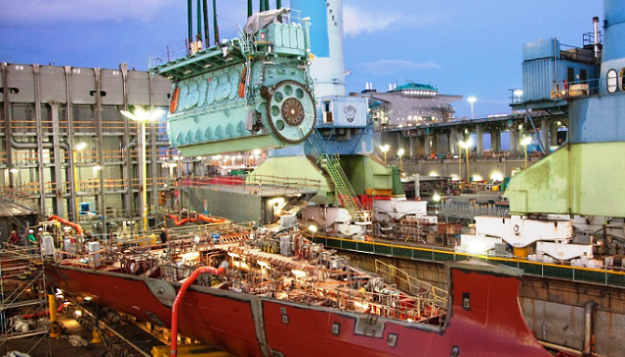The US Coast Guard published a Marine Safety Alert, highlighting the importance of maintaining safety measures, when inspecting a Gas Valve Unit (GVU) room, especially on board conventional LNG fueled vessels and Liquefied Gas Carriers.
The GVU is a multi-component device which manages the liquefied natural gas pressure supplied to the propulsion engines. The GVU room has an air intake and exhaust system designed to continuously ventilate and exchange the air within the space to reduce fire, explosion, and hazardous atmosphere risks from developing if gas leaks should occur from the equipment. The atmosphere of the room is monitored by a catalytic methane sensor located near the inlet to the room’s ventilation exhaust trunk. The GVU room’s ventilation creates a vacuum within the room when the two access doors are shut.
In particular, USCG Port State Control Officers performed an examination on board a Liquefied Natural Gas (LNG) carrier and presents deficiencies. During a repair on one cylinder of a main engine vessel, engineers had to remove an expansion bellows. Upon replacement of the bellows an O-ring, separating its inner and outer sections, was damaged. This error went unnoticed until a crew member was making a round in the enclosed GVU room while the engine had been operating on gas. After entering the GVU room he was overcome by methane gas and nearly lost consciousness.
Fortunately, he was able to exit the space into a safe atmosphere. After the incident the GVU room atmosphere was measured to be 22% methane and 17% oxygen by volume. Methane is an asphyxiant which displaces oxygen and is extremely flammable. The installed methane sensor failed to detect the accumulation of gas despite not having malfunctioned.
Engineers traced the methane leakage to the recently removed bellows and replaced the damaged O-ring. To prevent future accumulation of gases they rigged a hose from the outlet of the gas evacuation fan, across the GVU room to the sensor at the entrance exhaust duct. This unauthorized arrangement, which was identified during a Coast Guard examination, could have likely disabled the sensor’s ability to detect methane leakages from other components within the GVU room.
The causal factors in this case include:
- an inadequate fix of a component leading to the dislodging of an O-ring;
- gas leakage captured and returned back to the GVU room but not removed from the room;
- an accidental exposure / personnel casualty caused by a lack of oxygen and excessive gas accumulation; and
- a second potentially hazardous condition due to the unapproved installation of the exhaust hose, which would likely disable the methane sensor’s effectiveness in monitoring other components for leaks within the GVU room.
As a result of this discovery, the US Coast Guard strongly recommends that owners and operators:
- Emphasize to their organization’s technical shore side and vessel personnel the importance of following:
- Manufacture guidance;
- Recommendations in terms of maintenance and repair procedures;
- Methods to validate successful repairs involving critical systems, including leakage detection; and
- Procedures to evaluate corrective modifications (e.g., the use of the exhaust hose), even if intended to be temporary, to ensure they do not create additional safety hazards.
- Urge their vessel personnel to request additional expertise such as classification societies and manufacturer representatives when technical issues arise (e.g., the failure of the GVU room sensor to detect gas leakage or potential inadequate diffusion and circulation of air exchanges
within the GVU room) to ensure the most effective corrective actions and system alterations take place as needed. - Make notifications to the proper Flag State authorities and classification societies regarding potentially hazardous conditions before making any modifications to existing approved installations, arrangements, or proceedures.
The Coast Guard strongly recommends to Flag States, classification societies, underwriters and insurers that respective examiners, surveyors, and inspection personnel maintain an acute awareness regarding any system modifications, whether deemed potentially hazardous or not, to ensure such modifications have received the proper engineering reviews, approvals, and supporting documentation.
Further information may be found in the following notice:































































